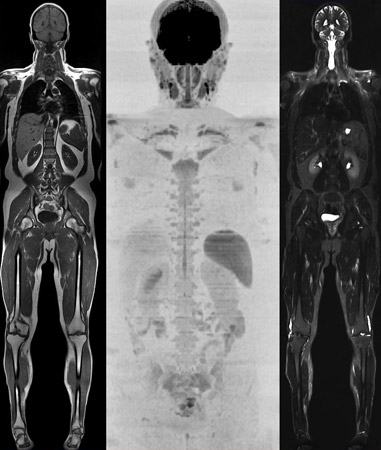A large study presented Sunday at the European Congress of Radiology has determined that Whole Body MRI is the safest and most accurate method of detecting disease pathology in persons who show little or no symptoms.
Dr. Andrzej Cieszanowski, a radiologist from the Medical University of Warsaw and one of the authors of the study, cited excellent soft tissue contrast, good spatial resolution, reasonable sensitivity and specificity and no ionizing radiation as reasons for why MRI is ideal for whole body diagnostics. “Additionally, we could use this technique to assess the prevalence of abnormalities in the general population, in different age groups, and we hope that it could give us some insight into the natural history of some lesions,” said Dr. Ciezanowski.
 The study looked at two age groups: 215 patients at a mean age of 57.9 years formed the over-50 group; 451 patients with a mean age of 40.9 years formed the under-50 group. All patients were scanned on a 1.5 Tesla MRI machine over the period of December 2009 – April 2013.
The study looked at two age groups: 215 patients at a mean age of 57.9 years formed the over-50 group; 451 patients with a mean age of 40.9 years formed the under-50 group. All patients were scanned on a 1.5 Tesla MRI machine over the period of December 2009 – April 2013.
Two radiologists divided the findings of the scans into three categories: type I – low significance, type II – findings of medium significance that may require follow up, and type III – significant findings requiring treatment and/or follow up. Throughout all three categories, the scans picked up findings in 659 of the patients (98 per cent). There were 2997 type I lesions, 363 type II lesions and 15 type II lesions found in total. “Type III findings included one brain glioma, one bronchogenic carcinoma, one renal cell carcinoma, one complicated renal cyst, one ovarian tumor, one testicular Leydig cell tumor, and metastases to the lung, liver, and adrenal gland in one patient,” Dr. Cieszanowski said.
These findings point to the importance of managing cancer growth through early detection, and the need to introduce whole body screening to populations on a wider level, especially for individuals over 50.
“All of our findings were more common in individuals over 50 years of age; however, some of our findings were present in significant numbers in subjects below 50 years, including brain infarcts, degenerative spine disease, hepatic cysts, hemangiomas, and renal cysts,” said Dr. Cieszanowski.
To read more about the whole body study, click here.

